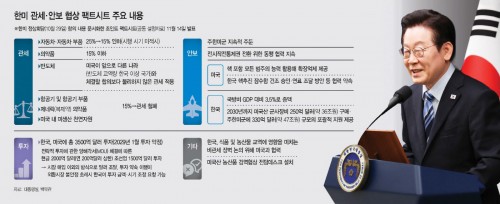 |
Senior presidential aides have revealed behind-the-scenes details of the five-month tug-of-war that culminated in the Korea–U.S. joint fact sheet announced on November 14. Their remarks highlight just how difficult—at moments even “shocking”—the initial American proposal had been.
Speaking at a press briefing at the presidential office in Yongsan, President Lee Jae-myung personally introduced the main points of the fact sheet. He emphasized that in a world where “there are no eternal friends or allies,” national interest ultimately depends on the country’s ability to project strength. Every negotiation, he said, serves as a reminder that “only by elevating our national standing and capabilities can we secure the lives and interests of our people.”
While the president’s comments were measured, the three senior aides who led the negotiations did not hide how fierce the process had been. Kim Yong-beom, chief of staff for policy, described the first U.S. offer—sent shortly after the August summit in Washington—as “so outrageous you could call it shocking,” adding that it made him think, “So this is what an Eulsa-year treaty looks like,” invoking the 1905 Eulsa Treaty, a symbol of foreign coercion.
Chief of Staff Kang Hoon-sik said the two sides held “as many as 23 ministerial-level meetings,” underscoring the intensity and pace of communication over the past five months. Both Kang and National Security Advisor Wi Sung-lac stressed that President Lee was “the firmest” negotiator throughout the process and credited him with steering the talks to a more balanced outcome.
Five Months of Holding the Line Pays Off
President Lee opened his remarks by thanking U.S. President Donald Trump for his “decisive judgment,” while at the same time indirectly criticizing Washington’s unilateral tendencies. International society, he noted, has “virtually no binding legal norms,” making it essential for Seoul to strengthen its capacity in every negotiation.
The final agreement reflects the results of what aides described as a prolonged “holding strategy.” The joint fact sheet includes a series of comparatively favorable terms for South Korea, surpassing what earlier negotiating partners had secured. Key outcomes include:
A cap of US$20 billion per year on Korea’s investment contributions to the U.S., with payment in installments (total US$350 billion).
Most-favored-nation treatment on semiconductor tariffs.
U.S. support for expanding Korea’s rights in uranium enrichment and spent-fuel reprocessing.
Approval for Seoul to pursue nuclear-powered submarine construction.
Reaffirmation that U.S. Forces Korea will remain under the framework of the 2006 bilateral agreement.
A commitment from both leaders to continue cooperation toward wartime operational control transfer.
These provisions collectively mark a major diplomatic achievement for the Lee administration, especially given the overwhelmingly unfavorable initial proposal described by negotiators.
Most Read
-
1
-
2
-
3
-
4
-
5
-
6
-
7





















